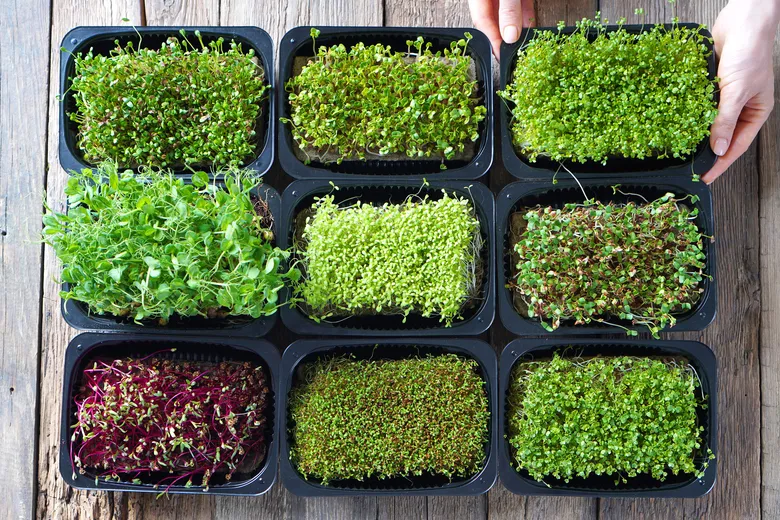Microgreens are a quick, nutritious way to add fresh flavor and crunch to meals like salads, sandwiches, and smoothies. They are similar to sprouts, but unlike sprouts, microgreens are grown in soil or seed-starting mix, and require light to grow their first set of leaves. While a grow light is ideal, a bright, cool windowsill can also work for growing microgreens such as rye or wheatgrass for pets, or peas.
Best Microgreens for Beginners
While many seeds can be used to grow microgreens, the most successful types are those with larger seeds that sprout quickly. Sunflower seeds are one of the fastest-growing options and are easy to grow. Peas are also beginner-friendly, as are microgreens from the cabbage family. A fun and surprising choice is popcorn—when grown as microgreens, popcorn shoots taste like sweet, tender corn.
Microgreens are harvested by snipping off the shoots at the soil line when they’re a few inches tall. You can safely use certified organic seeds for sprouting or those specifically sold for microgreens. Many people use organic bulk seeds, like sunflower or wheatgrass, and sometimes even garden seeds for smaller batches of peas or mustard greens.

How to Grow Microgreens
Growing microgreens differs from traditional plant cultivation, as seeds are not buried but sown on top of damp seed-starting mix or fresh potting soil. Gently press the seeds into the surface and space them close together. Mist the seeds with water, then place them in a warm, humid spot. A common spot for germination is on top of the refrigerator or under a seedling light. Cover the seeds with damp newspaper, and mist them twice a day for optimal growth.
Most microgreens will sprout within 3 days. After germination, move them to a bright spot and continue to keep them moist. Sunflower and sweet corn microgreens mature in about a week, while peas and cabbage need 12 to 14 days. Beets and cilantro are slower-growing and may take several weeks to be ready for harvest.

Microgreens do not require deep containers. Shallow trays or small containers with good drainage work well. Though drainage is not essential, containers with holes allow for better water absorption, especially for slower-growing types. For convenience, small containers that fit on window frames are perfect for growing microgreens indoors.
Growing Wheatgrass for Pets
Two years ago, I grew wheat and rye as microgreens to feed to my chickens, but my cats discovered the tender grass and loved it. Now, I grow wheatgrass specifically for my cats, but it’s also great for chickens, parakeets, or even yourself! You can eat the microgreens by juicing them or adding them to smoothies.
The Nutritional Power of Microgreens
Microgreens are packed with nutrients. Researchers at the Food Quality Lab in Beltsville, Maryland, found that microgreens contain up to five times the vitamins and carotenoids of mature plant parts. For example, red cabbage, cilantro, red amaranth, and green daikon radish scored highest for nutrition. Buckwheat microgreens are also rich in vitamins and protein.
Growing microgreens is easy, fun, and healthy—perfect for enhancing meals and providing extra nutrition for both humans and pets. Why not give it a try?
